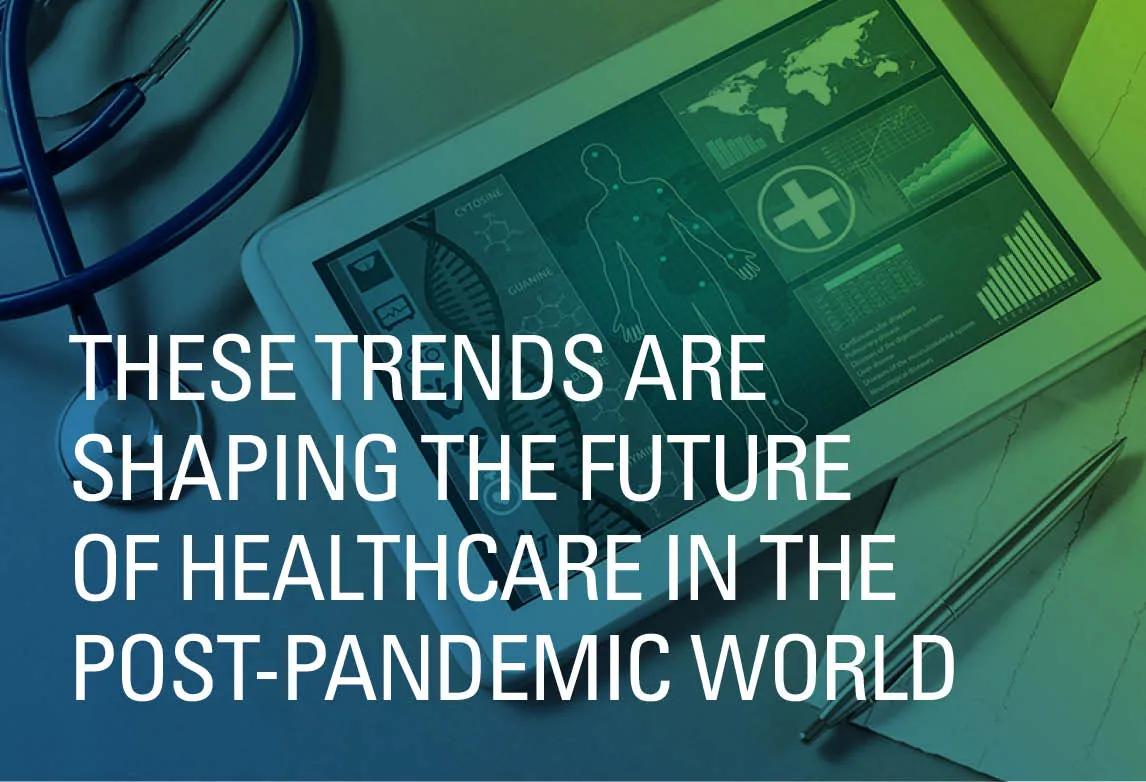
The Workforce Whirlwind: Seven Trends Stirring up the Healthcare Industry in 2024

Healthcare industry trends in 2024 include a focus on healthcare accessibility for underserved communities, propelled through an increased use of telemedicine and personalized medicine. Technological advancements in AI are set to mitigate growing issues the industry is facing this year — not only in patient-facing care, but in areas including allied healthcare and cybersecurity.
How might these trends play out through the second half of 2024? Read below for a summary of the seven leading healthcare trends in 2024 stirring up the industry.
Healthcare in 2024 at a Glance
The 2023 healthcare industry faced major conflict due to high inflation rates and labor shortages. Healthcare staffing proved to be especially straining. In November of 2023, approximately 102 million Americans lived in a primary care Health Professional Shortage Area (HPSA). 77 million Americans lived in dental HPSAs, and almost half of Americans lived in mental health HPSAs.1
According to recent estimates, recovery is expected. According to Globe Newswire, “the global market for Healthcare Staffing estimated at $40.3 Billion in the year 2023, is projected to reach a revised size of $62.2 Billion by 2030, growing at a CAGR of 5.6% over the analysis period 2023-2030.”2
The recovery of the healthcare industry is also driven by other various factors, including cost optimization and reimbursement-rate increases. This means the healthcare industry may be reaching an equilibrium in 2024.3
What does this recovery mean for the healthcare industry? How did healthcare staffing shortages create these developments? Continue reading for seven ways the healthcare industry responded to previous years’ challenges.
#1: Increased Use of Telemedicine
In the last two years, telehealth has seen dramatic shifts since the end of the peak of the COVID-19 pandemic. Some telehealth platforms are shifting their strategies to mitigate potential losses as telehealth use evens out. For instance, in April of 2024, Walmart closed its fifty-one health centers alongside its virtual care services. This news comes days after UnitedHealthcare announced the closure of their telehealth business, Optum.4
Despite these shifts, local and federal governments recognize the importance of access to telehealth, especially considering healthcare shortages. Many municipalities may make efforts to uphold telemedicine services. For instance, a federal grant from the United States Department of Agriculture recently expanded telehealth access in rural Alabama. The grant is expected to impact over 37,000 Alabamians who may live in HPSAs. It has the goal of giving patients access to not only primary physicians, but specialists.5
Although telemedicine has settled since surging during the COVID-19 pandemic, it remains an important structure in healthcare, especially to combat healthcare shortages.6 It has become especially important in communities with otherwise limited access to healthcare resources — including those who live in rural areas, those who are require gender-affirming care and those who have limited mobility, among other populations.7
#2: Focus on Mental Health
The US may be facing a mental health crisis. The National Alliance on Mental Illness reports one in every five adults experiences mental illness every year, and one in every twenty experience serious mental illness.8 According to a survey done by the APA, many mental healthcare professionals do not have room to accept new patients, indicating a shortage of mental healthcare professionals across the nation.9
Nationwide, healthcare providers are working to ensure that mental health needs can be covered similarly to other healthcare needs. In fact, UnitedHealthcare recently faced penalties in Minnesota for failing to cover claims for mental health services in proportion to other services.10 This indicates a growing focus on mental health services, and an increased need to train more professionals in the field.
#3: Personalized Medicine
Forbes writes that personalized medicine is the new trend to watch for in 2024, due to improvements in bioinformatics, immunotherapy and pharmacogenetics alongside other medical breakthroughs. Forbes also theorizes this trend emerged as patients seek solutions even among healthcare shortages.11 This has led to many physicians embracing customized healthcare treatments to best fit their patients.
Patients may seek out personalized healthcare solutions to be better informed and to actively participate in their own health.12 Personalized medicine may look to be dictated by genetics, lifestyle, and environment. It may also be applied to diagnostics, treatment, and healthcare delivery.13 Many patients may seek personalized healthcare solutions through various tools, including telehealth and online solutions.
#4: Healthcare Data Security
2023 saw an unprecedented increase in healthcare cybersecurity breaches. Not only are the breaches increasing in number, but in severity. 2021 saw 45.9 million records breached, 2022 saw 51.9 million records, but 2023 more than doubled the previous year’s record with 133 million records exposed.14 Cybersecurity professionals theorize this sharp rise in breaches is due to an increased digitization of healthcare records, alongside a growing sophistication of cybersecurity attacks.15
Additionally, AI presents brand new challenges which experts must tackle. While AI can be utilized to carry out sophisticated breaches, many experts are seeking ways to apply AI to their security efforts. Many experts predict more cybersecurity systems must rely on AI to work at the speed of a machine to find and patch potential weak points.16 With so much at risk, including medical records, supplier information, and the functionality of medical devices, these experts believe it’s crucial to implement the right digital tools alongside human expertise.
#5: Sustainable Healthcare Practices
The American Hospital Association (AHA) defines sustainability, as it pertains to healthcare, as “the integration of environmental stewardship, social equity and fiduciary responsibility to support healthy, equitable and resilient environments and communities over time.”17 It is well understood one’s environment can affect their physical and mental health, especially regarding health concerns such as lung disease, cancer, and skin health. Therefore, healthcare organizations, as a collective, are embracing advocating for sustainability.
The World Health Organization suggests ten practices for embracing sustainability in healthcare. These practices include “prioritizing disease prevention, health promotion and public health services” and “minimizing and adequately managing waste and hazardous chemicals.”18 WHO hopes these ten practices will form the core strategy for healthcare organizations around the world looking to embrace sustainability.
#6: AI and Machine Learning
The applications for AI and machine learning in healthcare are varied and wide-reaching. Some applications include diagnostics, data management and even robotic surgery.19 Some healthcare organizations may see AI tools as the answer to growing issues plaguing the healthcare industry, including the healthcare professional shortage.
Despite the promises that AI may seem to make, the technology is still relatively new, and many organizations may hesitate to implement AI tools. The World Economic Forum notes that, often, AI technology is evolving faster than policy can regulate it. They suggest taking an approach which moves forward with caution.20
#7: Healthcare Accessibility
In March of 2024, the AHA spoke to the U.S. House of Representatives on the growing importance of healthcare accessibility, particularly in rural and underserved areas. In their statement, they lay out current statistics regarding the state of emergency healthcare accessibility. They cite issues such as worker shortages, high drug prices, and underpayment by Medicare and Medicaid as threats to accessibility.21
To solve these issues, the AHA suggests embracing new solutions, including making permanent the Medicare-dependent Hospital and Low-volume Adjustment and improving access to capital to create financial stability. To bolster the workforce, the AHA advocates for policies such as loan repayment programs, boosted nursing education and expedited visas for foreign trained nurses and doctors. The hope is that implementation of programs such as these can provide emergency healthcare access to more Americans.
Healthcare Industry Trends in 2024: The Outlook
The outlook for the healthcare industry in 2024 features areas of optimism, alongside issues which the industry must mobilize to address. Digital tools, including telemedicine and AI, may aid in providing accessibility for underserved communities. All areas of healthcare, from patient-facing care to allied healthcare and cybersecurity, may feel the strain of prevalent issues regarding staffing and funding. However, they may also benefit from increased mental health efforts, sustainable healthcare practices, and increased cybersecurity awareness.
These trends represent some of the ways the healthcare industry could evolve in 2024. However, the actual trends may vary based on a variety of factors including technological advancements, policy changes, and societal shifts. Overall, innovation and the desire to care for patients may be the driving motivator to see a more stable healthcare industry for the remainder of 2024.
1 State of the U.S. Health Care Workforce, 2023. The National Center for Health Workforce Analysis. May 2024. Accessed June 27, 2024. https://bhw.hrsa.gov/sites/default/files/bureau-health-workforce/data-research/state-of-the-health-workforce-report-2023.pdf
2 Global Healthcare Staffing Business Report 2024: Market to reach $62.2 billion by 2030 – travel nurse staffing leads, staffing companies grow in prominence. GlobeNewswire News Room. May 13, 2024. Accessed June 27, 2024.https://www.globenewswire.com/news-release/2024/05/13/2880571/0/en/Global-Healthcare-Staffing-Business-Report-2024-Market-to-Reach-62-2-Billion-by-2030-Travel-Nurse-Staffing-Leads-Staffing-Companies-Grow-in-Prominence.html.
3 Patel N, Singhal S. What to expect in US Healthcare in 2024 and Beyond. McKinsey & Company. January 5, 2024. Accessed May 21, 2024. https://www.mckinsey.com/industries/healthcare/our-insights/what-to-expect-in-us-healthcare-in-2024-and-beyond
4 Landi H. How the Virtual Care Market is shaking out in 2024 as Walmart, Optum exit the telehealth business. Fierce Healthcare. May 1, 2024. Accessed May 14, 2024. https://www.fiercehealthcare.com/health-tech/how-walmart-and-optum-exiting-telehealth-signals-major-shift-virtual-care-market
5 Simmons M. Grant given to make telehealth easily accessible in rural Alabama. https://www.wtvy.com. April 18, 2024. Accessed May 10, 2024. https://www.wtvy.com/2024/04/18/grant-given-make-telehealth-easily-accessible-rural-alabama/
6 Charleson K. Telehealth statistics and telemedicine trends 2024. The Checkup. April 24, 2024. Accessed May 14, 2024. https://www.singlecare.com/blog/news/telehealth-statistics/
7 Eresman K. What are the benefits of telehealth? GoodRx. January 30, 2023. Accessed May 14, 2024. https://www.goodrx.com/healthcare-access/telehealth/telehealth-benefits-for-patients
8 Mental health by the numbers. NAMI. May 3, 2024. Accessed May 16, 2024. Hc. Mental Health By the Numbers | NAMI
9 Stringer H. Mental health care is in high demand. psychologists are leveraging tech and peers to meet the need. Monitor on Psychology. January 1, 2024. Accessed May 16, 2024. https://www.apa.org/monitor/2024/01/trends-pathways-access-mental-health-care
10 Timar-Wilcox E. Unitedhealthcare faces state penalty for uneven mental health care coverage. MPR News. May 14, 2024. Accessed May 17, 2024. https://www.mprnews.org/story/2024/05/14/unitedhealthcare-faces-state-penalty-for-uneven-mental-health-care-coverage
11 Garcia-Ibáñez R. Council Post: Why personalized medicine is a business trend to watch in 2024. Forbes. March 5, 2024. Accessed May 17, 2024. https://www.forbes.com/sites/forbesbusinesscouncil/2024/03/04/why-personalized-medicine-is-a-business-trend-to-watch-in-2024/?sh=3967e5047b52
12 Personalized patient care: Why it matters. Healthcare Blog. August 22, 2023. Accessed July 9, 2024. https://www.experian.com/blogs/healthcare/personalized-patient-care-why-it-matters/
13 Magloff L. 5 emerging trends in personalized medicine. Interesting Engineering. January 29, 2024. Accessed May 20, 2024. https://interestingengineering.com/lists/5-new-trends-in-personalized-medicine
15 The increasing menace to healthcare data security. Medical Device Network. February 13, 2024. Accessed May 20, 2024. https://www.medicaldevice-network.com/analyst-comment/increasing-menace-healthcare-data-security/
16 The role of AI in Healthcare Cybersecurity: Enhancing Threat Detection. Old National Bank. February 20, 2024. Accessed May 20, 2024. https://www.oldnational.com/resources/insights/the-role-of-ai-in-healthcare-cybersecurity-enhancing-threat-detection/#:~:text=Testing%20and%20Fine%2DTuning%20Response,and%20cut%20off%20attacker%20access
17 Sustainability for health care – achieving your sustainability goals: AHA. American Hospital Association. February 28, 2024. Accessed May 20, 2024. https://www.aha.org/sustainability
18 Environmentally Sustainable Health Systems: A strategic document. World Health Organization. February 7, 2017. Accessed May 20, 2024. https://www.who.int/publications/i/item/WHO-EURO-2017-2241-41996-57723
19 Thiel SBT. Ai in Healthcare: Uses, examples and benefits. Built In. May 1, 2024. Accessed May 14, 2024. https://builtin.com/artificial-intelligence/artificial-intelligence-healthcare
20 How AI in healthcare can revolutionize medicine worldwide. World Economic Forum. January 17, 2024. Accessed May 16, 2024. https://www.weforum.org/agenda/2024/01/ai-in-healthcare-buckle-up-for-big-change-but-read-this-before-takeoff/
21 AHA statement to house on “Access to health care in america: Ensuring resilient emergency medical care”: AHA. American Hospital Association. March 18, 2024. Accessed May 20, 2024. https://www.aha.org/lettercomment/2024-03-18-aha-statement-access-health-care-america-ensuring-resilient-emergency-medical-care
About the Author
 Tommy Moon
Tommy MoonTommy Moon is the Senior Vice President of Career Services. Since joining Ultimate Medical Academy in 2016, he has overseen the support services that align with the organization’s vision to champion student outcomes, including career placement, externships, registration, certification, employer partnerships, and alumni services.

